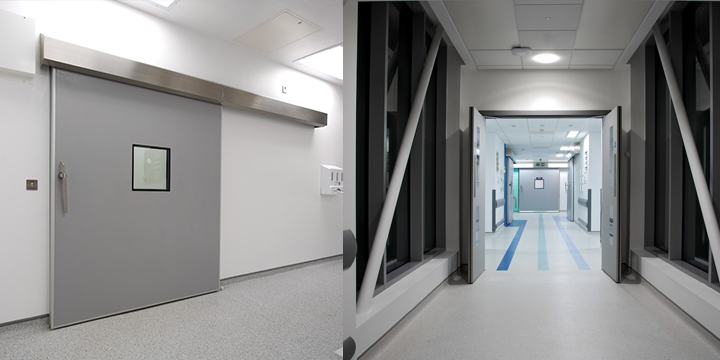Hygiene and Infection control are particularly crucial in isolation or quarantine areas where patients are infected with highly contagious diseases or viruses which need to be contained. These viruses can be easily transmitted from person to person through airborne contamination or contaminated surfaces such as door handles.
Specialist Doors for infection control and prevention
Doors can be a major source of contamination due to the fact they are the piece of furniture which is touched the most by patients and staff. This is why it’s critical that the correct doors are specified across isolation wards and quarantine areas within hospitals.
Doors in these areas should be easily cleaned and resistant to disinfection procedures in order to maximise infection control. Door surfaces should be constructed from inorganic materials such as GRP and also minimise or eliminate joints that can harbour bacteria. Hermetically sealing doors should be chosen for high containment areas requiring air pressure control.
As well as being extremely hygienic, doors also need to be highly functional in order to meet the needs of staff working in the unit. Key design considerations for doors include the ability to provide a clear door opening to allow easy transfer of patients, beds and medical equipment. Glazed doors or doors with large vision panels should also be considered for easy observation without having to enter the restricted area.
Dortek Hermetically Sealing Doors for Airborne Precautions
Designed specifically for airlocks, quarantine and infection-controlled environments, Dortek’s hermetically sealing sliding doors are ultra hygienic with a smooth, flush surface, which prevents bacteria from harbouring. There are no profiles or unhygienic lips around the edge of the door which is often found in alternative versions of post formed or fabricated fibreglass doors.
The door has a unique patented track system so it seals perfectly against the floor and frame. The efficiency of the seal has been officially tested and results show it to be over 99% effective thus helping to reduce the spread of airborne infections, cross contamination and air handling costs.
These doors have a trackless floor to minimise the spread of infection and provide unobstructed access in and out of patient areas. The vision panels with privacy blinds enable continuous observation of patients without entering the room.
Doors can also be automated to provide hands-free entry and further reduce the risk of infection. Dortek use an intelligent automation which is key for user safety. Our door automations react to the smallest obstruction and photo sensors stop the door from closing onto passing traffic. We also provide access control systems, locking and interface with BMS (Building Management Systems) for extra security.
Our doors can be supplied with x-ray ratings, sound insulation and worldwide certified fire ratings for the added protection of patients and staff.
Here are some hospitals already benefitting from using Dortek hygienic doors:
- Sengkang General Hospital, Singapore
- Ng Teng Fong Hospital, Singapore
- Singapore General Hospital, Singapore
- KK Women and Children’s Hospital, Singapore
- National Heart Centre (NHC), Singapore
- National University Hospital, Singapore
- National Centre for Infectious Diseases, Singapore
- Alice Spring Hospital, Australia
- Vincent’s Private Hospital, Australia
- Royal Adelaide Hospital, Australia
- Mercy Hospital, New Zealand
- The London Clinic, Harley Street, UK
- Great Ormond Street Hospital, UK
- School of Hygiene and Tropical Medicine, UK
- Royal London Hospital, UK
- Guys and St Thomas Hospital, UK
- New York-Presbyterian Hospital, US



